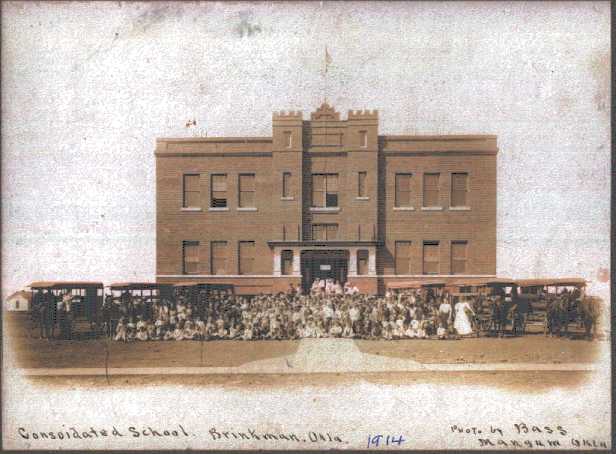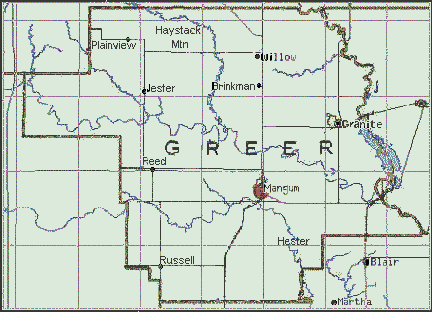


The town of Brinkman was laid out ten miles north of Mangum in 1910 when a railroad came through the area.The town was named after John Brinkman, a business associate of Joseph Kemp and Frank Kell, the builders of the railroad. They were from Wichita Falls, Texas.
The Plainview School District consisted of approximately twelve sections east of Brinkman joined with Prosperity which was west of Brinkman and about twice the size, along with three sections along the north side of the Hopewell District to form Brinkman Consolidated Number 1. As the name implies, it was the first consolidated school district in Greer County. Plainview and Prosperity had about the same number of students. The Plainview School was one half mile north and one and a half mile east of town. Prosperity was a half mile south, one mile west and a half south of the town.
Plainview and Prosperity school buildings were moved to Brinkman for classrooms for the 1910-11 school term. A $12,000 bond issue was passed to build and equip a new three story brick school building. This building was ready for the 1911-1912 school term. The school had 150 students and four teachers. The largest enrollment was in the 1920s when there were over 250 students. Many outside the district would room and board their children with people in the district so their children could attend the Brinkman school.
Brinkman was a farming community with cotton being the main crop. There were four cotton gins in Brinkman in the 1920s. Most of the settlers came to the area in the last few years of the nineteent and the first decade of the twentieth century. They had large families, but most of their children had finished school by the early thirties. The succeeding generations had smaller families which caused a decline in the school enrollment.
By 1934, the old three story building was condemned as unsafe. During the 1935-36 school year, the old building was torn down and a new one story building was constructed in it's place. The students attended classes in the town churches that year. When the Brinkman School started in July of 1936, the students were greeted with a beautiful new building. They knew it was the best school in the county, and many believed it was probably the best school in the state or anywhere else. They still had the old wooden gym, but plans were in the works to have a new gym by the 1937-38 school year. The school was constructed with red bricks and the gym was constructed with native stone. The WPA (Works Progress Administration) furnished the labor to build the buildings.

The drought and depression that started in 1929 took its toll on the people of the Brinkman Community. Some left to seek employment elsewhere, but most were able to stay until 1936 when many people left the area. 1936 was the driest year on record with only twelve inches of rain being recorded. Six inches fell in September which was little help for the summer crops. The cotton crop which many depended on for a livelihood was a complete failure. Many of the tenant farmers and those living in Brinkman that were dependent on farm wages were forced to seek employment elsewhere.
Many thought that when the drought and depression abated the people would move back, and Brinkman would once again be a prosperous town. Events were already in place where this would not happen. Better roads and cars made it possible for the people to go to larger towns to shop where better prices and selections were available. That and the people moving away forced many businesses to close. Tractors became more prevalent which allowed a farmer to farm more land. Wheat replaced cotton as the main crop. A farmer could farm more acres of wheat than he could cotton because of the lesser need of hand labor. World War II also added to the decline of the population as many entered the service, and others went to defense plants to seek employment.
As the people left, the school enrollment declined. The freshman class of 1940-41 had fourteen members. When this class graduated in 1944 there were only three. By 1946, the Brinkman School could not maintain the thirty average daily attendance for the high school to get state aid, so the high school students were bussed to Eastview. Those that did not want to go to Eastview could go elsewhere, but they had to furnish their own transportation. After three years, the Eastview school closed with most of the students coming to Brinkman where the facilities were better.
In 1957, the state required that each high school must have an average daily attendance of fifty students to receive state aid. The Brinkman School was forced to close. Most of the students went to Mangum or Granite with some of the Eastview students going to Reed.
The Brinkman School provided transportation for their students from the start. From 1910 to 1930, six school wagons served this purpose. High school boys that lived near the end of the routes would be the drivers. They were paid $40.00 per month. They would furnish their team and the feed, and the school would furnish the wagons and a barn to house the animals druing the day. The school wagons had kerosene heaters for cold weather, and side curtains that would roll up during warm weather. Usually a team would pull the wagon, but during extreme muddy conditions, it would take two teams. The routes were from five to seven miles long, and it would take an hour and half to cover them. The Brinkman school replaced it's wagons with busses for the 1930-31 school year. It was one of the last schools in the state to do so.
The Brinkman Alumni Association was formed in 1923, and it has met each year for seventy-nine years. They meet each year the Saturday before Labor Day. The 2001 meeting was held at the Mangum Methodist Church Fellowship Hall. There were 100 in attendance.
